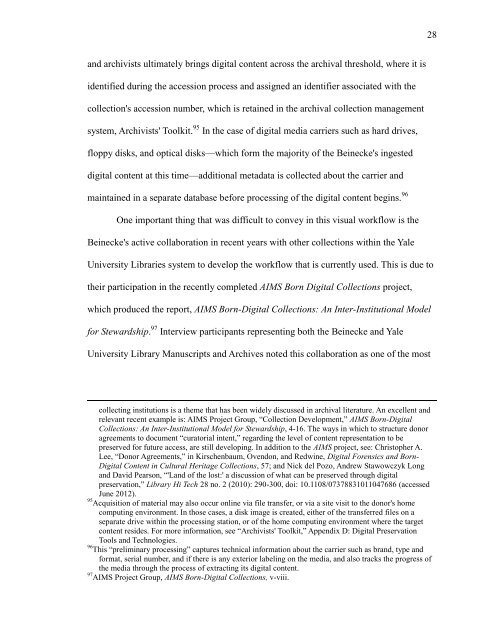gengenbach-forensic-workflows-2012
gengenbach-forensic-workflows-2012
gengenbach-forensic-workflows-2012
You also want an ePaper? Increase the reach of your titles
YUMPU automatically turns print PDFs into web optimized ePapers that Google loves.
and archivists ultimately brings digital content across the archival threshold, where it is<br />
identified during the accession process and assigned an identifier associated with the<br />
collection's accession number, which is retained in the archival collection management<br />
system, Archivists' Toolkit. 95 In the case of digital media carriers such as hard drives,<br />
floppy disks, and optical disks—which form the majority of the Beinecke's ingested<br />
digital content at this time—additional metadata is collected about the carrier and<br />
maintained in a separate database before processing of the digital content begins. 96<br />
One important thing that was difficult to convey in this visual workflow is the<br />
Beinecke's active collaboration in recent years with other collections within the Yale<br />
University Libraries system to develop the workflow that is currently used. This is due to<br />
their participation in the recently completed AIMS Born Digital Collections project,<br />
which produced the report, AIMS Born-Digital Collections: An Inter-Institutional Model<br />
for Stewardship. 97 Interview participants representing both the Beinecke and Yale<br />
University Library Manuscripts and Archives noted this collaboration as one of the most<br />
collecting institutions is a theme that has been widely discussed in archival literature. An excellent and<br />
relevant recent example is: AIMS Project Group, “Collection Development,” AIMS Born-Digital<br />
Collections: An Inter-Institutional Model for Stewardship, 4-16. The ways in which to structure donor<br />
agreements to document “curatorial intent,” regarding the level of content representation to be<br />
preserved for future access, are still developing. In addition to the AIMS project, see: Christopher A.<br />
Lee, “Donor Agreements,” in Kirschenbaum, Ovendon, and Redwine, Digital Forensics and Born-<br />
Digital Content in Cultural Heritage Collections, 57; and Nick del Pozo, Andrew Stawowczyk Long<br />
and David Pearson, “'Land of the lost:' a discussion of what can be preserved through digital<br />
preservation,” Library Hi Tech 28 no. 2 (2010): 290-300, doi: 10.1108/07378831011047686 (accessed<br />
June <strong>2012</strong>).<br />
95 Acquisition of material may also occur online via file transfer, or via a site visit to the donor's home<br />
computing environment. In those cases, a disk image is created, either of the transferred files on a<br />
separate drive within the processing station, or of the home computing environment where the target<br />
content resides. For more information, see “Archivists' Toolkit,” Appendix D: Digital Preservation<br />
Tools and Technologies.<br />
96 This “preliminary processing” captures technical information about the carrier such as brand, type and<br />
format, serial number, and if there is any exterior labeling on the media, and also tracks the progress of<br />
the media through the process of extracting its digital content.<br />
97 AIMS Project Group, AIMS Born-Digital Collections, v-viii.<br />
28


